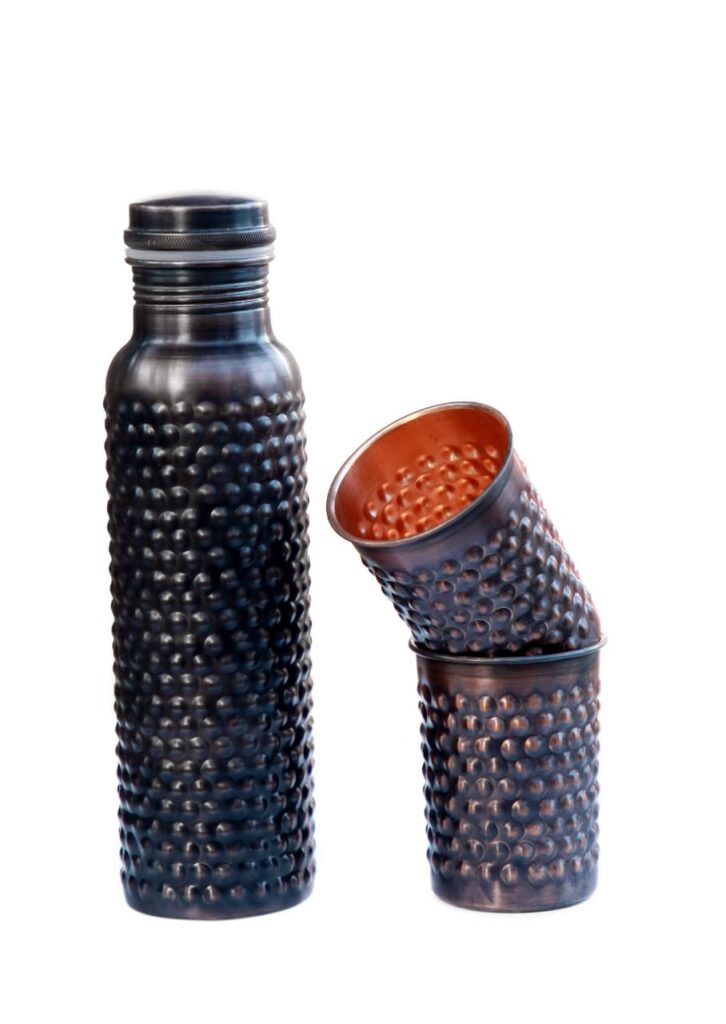Are copper-lined water bottles safe? Copper is a vital mineral crucial for energy production, connective tissue formation, and nervous system function. However, managing copper levels is delicate. Too much copper can cause toxicity, while too little can lead to deficiency, both with serious health implications.
“The Copper Conundrum” highlights the challenges and debates around copper. It’s essential for human health and technology but can be toxic in excess. Its mining also raises environmental concerns.
In sustainability and technology, copper is key for green energy transitions, being a component in wind turbines and solar panels. Yet, the demand for copper creates a paradox: achieving a net-zero carbon future may require extensive copper mining, which impacts the environment.
Addressing “The Copper Conundrum” involves navigating these complexities to ensure copper benefits society and technological advancement without harming health or the environment.
A Trip Down Memory Lane: Copper’s Glorious Past
Copper’s history is as rich and extensive as the metal itself.
Here’s a glimpse into its glorious past:
Copper was one of the first metals humans extracted and used, marking the end of the Stone Age and the start of the Metal Ages.
The Bronze Age: Alloying copper with tin to make bronze began the Bronze Age. The enhanced durability and strength of bronze tools and weapons revolutionized societies and cultures globally.
Copper in Ancient Civilizations: From the ancient Egyptians and Mesopotamian to the Romans, copper was revered for its utility and beauty.
Symbolism and Significance Beyond its practical applications, copper held significant symbolic and cultural value. It was seen as a symbol of eternal life, fertility, and divine protection in various cultures. Its captivating sheen and malleability made it a favorite for artisans and craftsmen.
Technological and Cultural Impact The versatility of copper made it a staple in ancient technology and art. It was used in everything from jewelry and coins to tools and weapons, influencing the course of history and the development of civilizations.
The Science Behind the Shine: Copper’s Hidden Talents
Copper, the versatile metal with a distinctive reddish hue, has a host of hidden talents that make it an invaluable resource in various industries.
Here’s a look at the science behind its shine:
Corrosion Resistance Copper’s durability is largely due to its natural resistance to corrosion. It forms a protective layer on its surface that shields it from environmental factors, making it ideal for use in a range of settings, from marine to industrial.
Antimicrobial Properties One of copper’s most remarkable features is its natural antimicrobial resistance. It can kill bacteria, viruses, and fungi upon contact by disrupting their cellular processes, which is why it’s used in medical settings and high-traffic areas to prevent the spread of disease.
High Conductivity Copper is second only to silver in terms of electrical and thermal conductivity. This property is crucial for its use in power generation and distribution, and it’s becoming increasingly important in renewable energy systems.
Malleability and Ductility Despite its toughness, copper is also highly malleable and ductile. It can be easily shaped, bent, and stretched, which allows for its use in intricate wiring and plumbing systems.
Recyclability Copper can be recycled indefinitely without any loss in quality. This makes it a sustainable choice, contributing to the circular economy and reducing the environmental impact of its use.
Myth Busting: Copper’s Kryptonite
While copper has many strengths, it’s not without its vulnerabilities.
Here are some of the challenges associated with copper, often considered its ‘kryptonite’:
Cost and Availability Copper is relatively expensive compared to other materials like aluminum and plastic, which can limit its use in certain applications. Its high cost also makes it a target for theft.
Corrosion Despite its general corrosion resistance, copper can still suffer from corrosion under certain conditions, especially when exposed to sulfur compounds, which can lead to a gradual degradation of the metal.
Weight Copper is heavier than alternative materials such as aluminum, which can be a disadvantage in applications where weight is a critical factor.
Bonding Issues In the semiconductor industry, copper is sometimes avoided due to its properties that can make it a less reliable bonding agent compared to other materials.
Electrical Shock Risks Copper wiring can pose higher shock risks compared to fiber optic cables, especially when improperly handled or installed.
Toxicity While copper is essential for health in small amounts, excessive exposure can lead to copper toxicity, which can cause severe health and neurological problems.
Material Showdown: Copper vs. The World
Are Copper Water Bottles Safe stands out in the material world for its unique combination of properties, which often makes it the material of choice for a variety of applications. Here’s a comparison of copper with other commonly used materials:

Aluminum vs Copper
- Conductivity: Copper has superior electrical and thermal conductivity compared to aluminum, making it ideal for electrical wiring and heat exchangers.
- Durability: While both materials resist corrosion, copper is generally more durable and has a longer lifespan.
- Cost: Aluminum is typically less expensive than copper, which can influence its use in budget-sensitive projects.
- Weight: Aluminum is lighter than copper, which can be beneficial in applications where weight is a concern, such as in the aerospace industry.
Steel vs Copper
- Corrosion Resistance: Copper is more resistant to corrosion than most steel, which is why it’s often used for plumbing in corrosive environments.
- Strength: Steel is stronger and harder than copper, which makes it suitable for structural applications.
Plastic vs Copper
- Heat Resistance: Copper can withstand higher temperatures than most plastics, making it suitable for high-temperature applications.
- Environmental Impact: Copper is more environmentally friendly than plastic, as it is 100% recyclable without loss of quality.
Other Metals (Brass, Bronze) vs Copper
- Machinability: Copper is easier to machine than many of its alloys like brass and bronze, which can be important for manufacturing processes.
- Cost: Alloys like brass and bronze can be more cost-effective than pure copper while still retaining many of its desirable properties.
Copper water Bottle Confessions
The Copper water bottles have become quite popular due to their perceived health benefits. Here’s some real talk about using copper bottles, based on common practices and expert advice:
1. Drinking Water from Copper Bottles It’s believed that water stored in a copper vessel can have antioxidant properties, improve the immune system, and aid digestion. However, it’s important to consume this water in moderation to avoid copper toxicity.
2. Lemon and Honey Water Avoid storing lemon and honey water in copper bottles. The acidic nature of lemon can react with copper, potentially leading to health issues like stomach pain or gas.
3. Cleaning Copper Bottles Regular cleaning is essential to maintain the bottle’s integrity and prevent oxidation. A thorough cleaning with salt and lemon is recommended every 30 days.
Conclusion
In conclusion, Are Copper-Lined Water Bottles Safe is a topic of debate and requires a nuanced understanding. While copper is an essential trace mineral necessary for human health and copper vessels have been used for centuries with claims of providing health benefits, there are also risks associated with their use.
Pros:
- Antimicrobial Properties: Copper has natural antibacterial effects, which may help in purifying water and making it safer to drink.
- Health Benefits: Some believe that water stored in copper bottle can offer antioxidant properties and aid in digestion and overall wellness.
Cons:
- Copper Toxicity: Excessive intake of copper can lead to toxicity, with symptoms like stomach ache and other health issues.
- Maintenance: Copper bottles require regular cleaning to prevent the buildup of bacteria and molds, which can lead to gastrointestinal illnesses.
The key to safely enjoying the benefits of copper-lined water bottles lies in moderation and proper maintenance. It’s important to not store water in them for too long, avoid acidic substances, and clean the bottles regularly. As with any health-related practice, it’s advisable to consult healthcare professionals for personalized advice. Ultimately, while copper-lined water bottles can be safe when used correctly, they are not necessarily suitable for everyone and should be used with caution.











